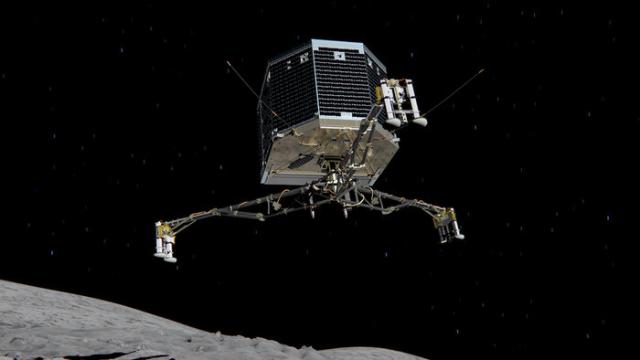Goodnight, Philae, though not, we hope, goodbye. The lander is now in sleep mode, keeping “all instruments and most systems on board shut down.” Thankfully, engineers managed to gather all the collected comet data before Philae’s batteries were depleted. If we’re lucky, it may wake up
when it gets closer to the Sun.
From now on, no contact would be possible unless sufficient sunlight falls on the solar panels to generate enough power to wake it up. The possibility that this may happen was boosted this evening when mission controllers sent commands to rotate the lander’s main body, to which the solar panels are fixed. This may have exposed more panel area to sunlight.
In case you haven’t been following the complete drama of a little machine on a ball of ice and rock 300 million miles away, a couple pieces of Philae’s landing gear didn’t work. It touched down but then bounced twice, eventually ending up in the dark shadow of a cliff. Philae’s solar panels weren’t getting enough sun, and when the initial charge on its battery ran out, it went dark, long before its planned March 2015 end date.
But before it died, Philae got to work, more urgently than ever. At top of its priorities was COSAC, or the COmetary SAmpling and Composition experiment, to analyse samples taken 25 centimeters below the surface of the comet. COSAC was looking for organic molecules, especially amino acids that are one of the building blocks of life. Amino acids have chirality, which means they can be left or right-handed, mirror images of each other. The amino acids on Earth are almost all left-handed, and if we find the same on the comet, it would lend credence to the theory that early life on Earth was seeded by comets crashing into our planet. COSAC is especially key because amino acids don’t vaporize, so there’s no way to study them except on the comet itself. Philae seems to have sent back COSAC data.
Another instrument, Ptolemy, is also gathering data on hydrogen isotopes to determine how much of Earth’s water may have originated with comets. Still other instruments have also been gathering data on the thermal and mechanical properties of the comet’s surface. The spacecraft Rosetta itself will continue orbiting the comet and return data from its own instruments through August 2015.
A last-minute manoeuvre to rotate a larger solar panel into the sunlight boosts the small possibility that Philae could get enough energy to reawaken. And as the comet itself gets closer to the sun, that possibility could grow.
The ESA has been putting an optimistic face on the comet mission despite Philae’s early hibernation, calling it “hugely successful.” Philae returned plenty of unprecedented data, even though it had only hours rather than months to collect it.
And for the rest of us watching at home, we weren’t watching because we were wondering about the isotopes of a random comet. Ten years ago, humankind sent a spacecraft on a 4 billion mile journey to catch a comet flying 40,000 miles per hour. Then we landed on it, using equipment that had laid dormant for a decade in the vacuum of space. We made — not perfectly, but we made it. [ESA]
Top image: Artistic impression of Philae’s descent on a comet. ESA.
